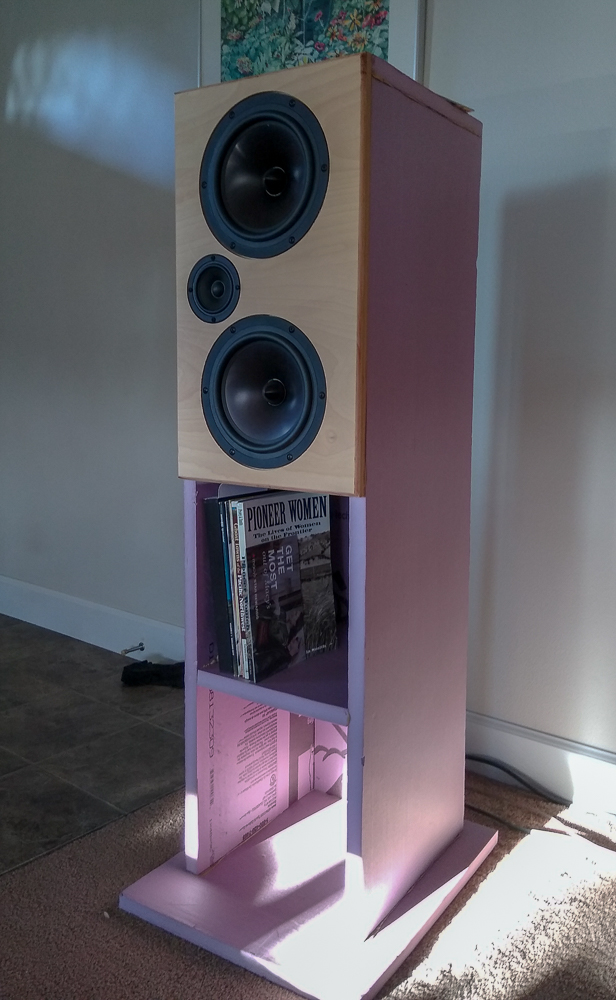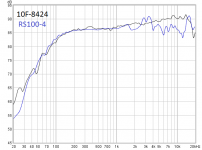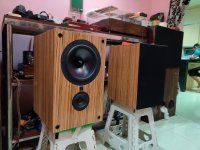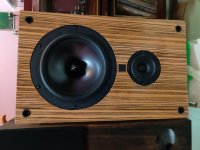2 use a pair of RS225's per side
I really liked these speakers with 1 RS225 per side.
I love these speakers with 2 RS225's per side. Just so good and so much fun.
Ah693973,
Have you built these speakers? I don’t recall seeing your build posted here.
If you have photos please post.
Thanks,
X
Have you built these speakers? I don’t recall seeing your build posted here.
If you have photos please post.
Thanks,
X
Ahh sorry about that - I forgot that those were yours. Nice XPS and wood hybrid. What did you do to get the dual woofers to work - use 2mH choke or DSP and active amp?

Active with JRiver. Just works really well. I love the setup.
My wife disagrees with you about the XPS/wood hybrid being nice. Once a week I get the much deserved hint that these were supposed to be temporary.
My wife disagrees with you about the XPS/wood hybrid being nice. Once a week I get the much deserved hint that these were supposed to be temporary.
Covering up the XPS might make your wife more agreeable. Wallpaper, vinyl wrap, primer/paint, veneer would all be possibilities. Even my incredibly patient and supportive wife would balk at having to look at pink construction insulation foam panels for very long in the family room. Her only stipulation to my getting into the hobby many moons ago was that the speakers had to look like furniture or sculpture.
I’m working on a budget version of this using the Dayton RS100-4 and I’ll report back once complete......BUT.....I’ve been doing comparative listening of the RS100 vs the 10F on an open 12x12 baffle for a few weeks now.....no filters and here’s my dilemma
With all things be equal including volume compensation, the RS100 exceeds the much more expensive 10F on detail and overall clarity. Pushed loud, the 10F holds up a tiny bit better but I would never listen at these volumes anyway and without the help of woofer, I’m not sure this comparison has any value.
With all things be equal including volume compensation, the RS100 exceeds the much more expensive 10F on detail and overall clarity. Pushed loud, the 10F holds up a tiny bit better but I would never listen at these volumes anyway and without the help of woofer, I’m not sure this comparison has any value.
RS100 is a fine driver and being aluminum cone, has a bit more detail resulting from a “tizz” like sound from the aluminum resonance. Some may like this sound better. There’s not a wrong choice by using RS100 or PS95-8. You might like FR88EX if you like aluminum sound.
MasPenk,
Looking very nice! Is that zebra wood?
Yes.. I found a local seller got a zebra wood veneer and brush it with PU...
Looks spectacular, MasPenk, I'm very envious. My cabinets are unfinshed after a year of use. Then, I always liked the look of birchply, and I have zero experience veneering.
I just revisited the L-pad settings of my RS225-10F/8414 setup, and realized that the Scan Speak I chose is 3-5 dB down through the mids to upper mids compared to the TC9FD they replaced. No wonder I've felt it lacked treble energy and presence. Cutting the attenuation by 2.3 dB or so restores that and makes the sound quite a bit more revealing. Welcome for some recordings but not all!
I'm also playing with adding inductance to the woofer coil, aimed at pushing more of the RS225 midrange below audibility. Added 0.40 mH (0.18 Ohm Re) and am evaulating now. Seems good, and I may try a Jantzen 15GA P-core in 6.0, only 0.29 Ohms Re. Could be interesting.
Anyone else try the 10F/8414?
I just revisited the L-pad settings of my RS225-10F/8414 setup, and realized that the Scan Speak I chose is 3-5 dB down through the mids to upper mids compared to the TC9FD they replaced. No wonder I've felt it lacked treble energy and presence. Cutting the attenuation by 2.3 dB or so restores that and makes the sound quite a bit more revealing. Welcome for some recordings but not all!
I'm also playing with adding inductance to the woofer coil, aimed at pushing more of the RS225 midrange below audibility. Added 0.40 mH (0.18 Ohm Re) and am evaulating now. Seems good, and I may try a Jantzen 15GA P-core in 6.0, only 0.29 Ohms Re. Could be interesting.
Anyone else try the 10F/8414?
The attenuation (pad) resistors on the mid-tweet is very much a YMMV affair. Adjust to taste. And depending on the driver, it may not be needed at all. I would have guessed that the 10F/8414 is more sensitive than TC9FD? Interesting to tweak the XO, try playing with it in Xsim and see what you get.
Yes, actual measurement of my implementation of your design would be incredibly helpful! I've been making educated guesses, then trial and error by ear, just like back in the days before computer simulation. Years ago I used Calsod and manf data, then a microphone and the Stereophile test CD to get a very rough frequency response. Will have to find a cheap used laptop to run a windows program like Xsim.
X - I've used your graph from page 1 of the thread, and hoping my similar baffle, woofer, and inductor are reasonably close. There's a questionable bump at 450 Hz and relatively depressed mid-tweet level around the crossover region. I assume we want to hear the very nice Scan Speak midrange and very little of what the woofer is doing in that wide crossover zone.
No, you want that RS225 to provide more at 450Hz IMO. It’s fine sounding there and has the oomph to give a mid bass chest punchy sound. The way this 1st order XO works is that the drivers are both so wide band that there is significant contributions from both through the XO region. And that’s ok - it’s what makes it sound good. Take that away and it becomes closer to a conventional steep order crossover.
The problem spot with the RS225 is the 7kHz breakup peaks. But that’s been handled by the notch filter (4.4uF and 0.47R across the terminals).
This XO was arrived at after extensive listening tests tweaks and simulation. If you want to change it, I suggest getting a microphone, REW, and Xsim and playing with it.
The problem spot with the RS225 is the 7kHz breakup peaks. But that’s been handled by the notch filter (4.4uF and 0.47R across the terminals).
This XO was arrived at after extensive listening tests tweaks and simulation. If you want to change it, I suggest getting a microphone, REW, and Xsim and playing with it.
Thanks X, this is information about the RS225 that I need. In fact, with the added inductance I'm trying right now, something is missing from the sound. Planning to go back to 4.0 mH. Also, I sense that just 2.67 dB attenuation is too little for the 10F/8414. There's a lack of substance through the midrange.
It's fun to play around with these values, though, even if I end up back at the original recipe on the woofer.
It's fun to play around with these values, though, even if I end up back at the original recipe on the woofer.
This is is DIY after all - and half the fun is tweaking and experimenting. But it’s is important to know why we are changing something and how much has it changed. Having measurement capability is not expensive as mic’s are $40 to $110 for a decent one. Software is free. I use the UMIK-1 USB mic calibrated by third party Cross-spectrum Labs. I think you could get 48v based mic from Dayton for $40 if you hare a mic preamp with ADC already (like a Behringer or Focus Solo etc).
Dayton Audio EMM-6 Electret Measurement Microphone
Behringer UM2 U-Phoria Audiophile 2 x 2 USB Audio with XENYX Preamplifier
So for $80, you can have a measurement solution that lets you design speakers and crossover quantitatively.
If you look at the measured and predicted frequency response and phase from this speaker and crossover, you will see that it is tough to beat a neutral flat response. There is a slight downward tilt from the lows to the highs which many people say gives a more pleasing balanced sound.
Dayton Audio EMM-6 Electret Measurement Microphone
Behringer UM2 U-Phoria Audiophile 2 x 2 USB Audio with XENYX Preamplifier
So for $80, you can have a measurement solution that lets you design speakers and crossover quantitatively.
If you look at the measured and predicted frequency response and phase from this speaker and crossover, you will see that it is tough to beat a neutral flat response. There is a slight downward tilt from the lows to the highs which many people say gives a more pleasing balanced sound.
Last edited:
Thanks for itemizing a very reasonable measurement system. I have to add a laptop to the list.
Fooling with the woofer rolloff is a definitely sketchy process. I know the transfer function is affected by many factors and often hard to predict when one of them is altered. Careful listening and notes can help to some extent.
Using Calsod and canned data or 1/3 octave hand notation I usually shot for some BBC dip, and still tend to go for that. But that's a controversial topic in its own right, and usually assumes some unpleasant bumps in the midrange.
Fooling with the woofer rolloff is a definitely sketchy process. I know the transfer function is affected by many factors and often hard to predict when one of them is altered. Careful listening and notes can help to some extent.
Using Calsod and canned data or 1/3 octave hand notation I usually shot for some BBC dip, and still tend to go for that. But that's a controversial topic in its own right, and usually assumes some unpleasant bumps in the midrange.
- Home
- Loudspeakers
- Full Range
- 10F/8424 & RS225-8 FAST / WAW Ref Monitor


